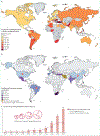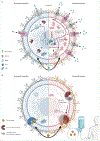Worldwide emergence of fluconazole-resistant Candida parapsilosis: current framework and future research roadmap
- PMID: 37121240
- PMCID: PMC10634418
- DOI: 10.1016/S2666-5247(23)00067-8
Worldwide emergence of fluconazole-resistant Candida parapsilosis: current framework and future research roadmap
Erratum in
-
Correction to Lancet Microbe 2023; 4: e470-80.Lancet Microbe. 2023 Aug;4(8):e576. doi: 10.1016/S2666-5247(23)00188-X. Epub 2023 Jun 15. Lancet Microbe. 2023. PMID: 37331370 No abstract available.
Abstract
Candida parapsilosis is one of the most commen causes of life-threatening candidaemia, particularly in premature neonates, individuals with cancer of the haematopoietic system, and recipients of organ transplants. Historically, drug-susceptible strains have been linked to clonal outbreaks. However, worldwide studies started since 2018 have reported severe outbreaks among adults caused by fluconazole-resistant strains. Outbreaks caused by fluconazole-resistant strains are associated with high mortality rates and can persist despite strict infection control strategies. The emergence of resistance threatens the efficacy of azoles, which is the most widely used class of antifungals and the only available oral treatment option for candidaemia. The fact that most patients infected with fluconazole-resistant strains are azole-naive underscores the high potential adaptability of fluconazole-resistant strains to diverse hosts, environmental niches, and reservoirs. Another concern is the multidrug-resistant and echinocandin-tolerant C parapsilosis isolates, which emerged in 2020. Raising awareness, establishing effective clinical interventions, and understanding the biology and pathogenesis of fluconazole-resistant C parapsilosis are urgently needed to improve treatment strategies and outcomes.
Copyright © 2023 The Author(s). Published by Elsevier Ltd. This is an Open Access article under the CC BY 4.0 license. Published by Elsevier Ltd.. All rights reserved.
Conflict of interest statement
Declaration of interests CJN is a cofounder of BioSynesis, a company developing diagnostics and therapeutics for biofilm infections. MH reports grants and research funding from Astellas Pharma, Gilead Sciences, MSD, Pfizer, Euroimmun, F2G, Pulmocide, IMMY, Mundipharma, and Scynexis, outside the submitted work. TG acknowledges support from the Spanish Ministry of Science and Innovation (PID2021–126067NB-I00), cofounded by European Regional Development Fund, the Catalan Research Agency (AGAUR) SGR423, the European Union's Horizon 2020 research and innovation programme (ERC-2016–724173); the Gordon and Betty Moore Foundation (GBMF9742), the La Caixa foundation (LCF/PR/HR21/00737), and the Instituto de Salud Carlos III (IMPACT Grant IMP/00019, and CIBERINFEC CB21/13/00061- ISCIII-SGEFI/ERDF). BZ acknowledges support from the National Key Research and Development Program of China 2021YFA0911300. All other authors declare no competing interests.
Figures



Comment in
-
Copy number variants of ERG11: mechanism of azole resistance in Candida parapsilosis.Lancet Microbe. 2024 Jan;5(1):e10. doi: 10.1016/S2666-5247(23)00294-X. Epub 2023 Nov 25. Lancet Microbe. 2024. PMID: 38012895 No abstract available.

